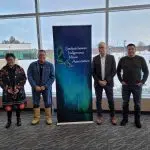
Farmers and Indigenous land users form new Treaty Land Sharing Network in Saskatchewan
A number of farmers and Indigenous land users across Saskatchewan are joining in a new Treaty Land Sharing Network just formed.
About 20 farmers, ranchers, and other landholders from the North Battleford area to the Regina area signed on as members to honour Canada’s treaty relationship of sharing the land with Indigenous peoples and welcoming them to practise their traditional way of life.
Producer Mary Smillie whose farm borders on Treaty 4 and Treaty 6 property near Davidson, Sask., is among those involved in promoting the network.
She hosted the Treaty Land Sharing Network launch event at her family’s grain and livestock farm in Bladworth on July 15, that included guest speakers, Bradley Desjarlais, a hunter from Fishing Lake First Nation, and Treaty Commissioner of Saskatchewan, Mary Culbertson. More farmers signed on to the network at the event.


